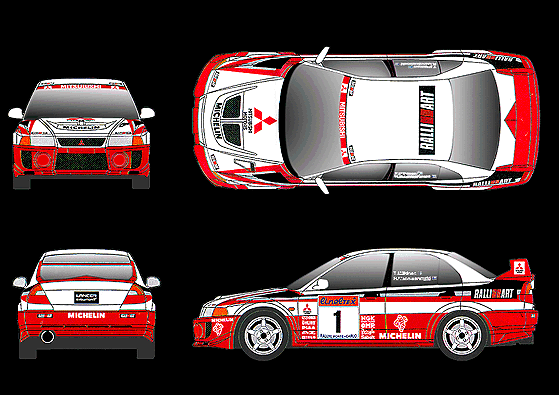 |
Lancer Evo V |
 |
Mitsubishi is a relative newcomer to the World Rally Championship but the company has already been extremely successful. It took a lot of enthusiasm and effort to bring the Lancer to its current version, the Evolution VII, the latest and most impressive incarnation of all street legal 4 wheel driven turbocharged cars. The company's first attempt at the WRC title was incarnated by the Mitsubishi Galant with some success in 1991 and 1992.
The first Lancer to compete in the WRC appeared back in 1993 at the Monte Carlo Rally. It was then driven by Armin Schwarz and Kenneth Eriksson. This first version was soon to be followed by the Evolution II of the Lancer which made its debuts at the 1994 Monte Carlo Rally no longer than a year after the initial version was introduced. The celerity with which the next generation was introduced denotes both the determination of the Japanese company to be as competitive as possible very quickly as well as the seriousness of the involvement of Ralliart the company that is responsible for building the rally cars. Ralliart, an England based company, is run by Andrew Cowan. The Evolution II was driven by Kenneth Eriksson and Isolde Holderied. Next came the famous Lancer Evolution III which debuted at the Corsica Rally in 1995, a year and a half after the introduction of the Evolution II. This version (the evo III) is, to this date, a hard to beat contender in the GroupN class. The evo III was driven by Andrea Aghini at its debut rally.
By the end of the 1995 season the FIA regulations authorized the WRC class cars to compete. Mitsubishi did not find any particular interest in this formula and continued to produce GroupA rally cars. The company's reply to WRC cars was the Lancer RS Evolution IV. This was an awesome car that contained some of the most bewildering technology ever to be available on sale on any manufacturer's catalogue. The evo IV was introduced at the 1997 Monte Carlo Rally, driven by Tommi Mäkinen and Richard Burns.
After running alongside the WRC cars for almost a year and allowing Tommi Mäkinen to be the World Rally Champion, the Lancer Evolution IV was replaced by the Evolution V at the beginning of 1998. By then it was difficult to differentiate the Lancer Evo V from a WRC car. It had the same width as WRC cars had and some of the modifications applied to the Evo IV, in order to produce the evo V, clearly put the evo V in the WRC class. The Lancer Evo V was still a GroupA class car though which means that at least 2500 Evo V had to be produced in order to comply with the FIA rules.
This was very good news for rally car amateurs since it meant they could, theoretically, buy a Lancer Evo V. The bad news was that all evo V cars were reserved to the Japanese market and although they could still be purchased from other countries this could only be done through personal import channels. Personal import procedures are very dependent upon the country of import and span from easy to impossible passing from complex and extremely expensive.
The Mitsubishi Lancer RS Evolution V
Of all the successive evolutions of the Lancer the most significant ones were the Evolution IV and evolution V. Introduced in the Evolution IV was an engine rotated by 180°, compared to the Evo III, so that the gear box was relocated on the left side were the driver sits. This positioning offered a better balanced weight distribution. This engine orientation was maintained on the Evo V and later models. The Evo V's main innovations come from a heavily upgraded engine management system, a relocated and upgraded intercooler, new aerodynamics, upgraded brakes and of course a totally redesigned suspension layout. This last point is, naturally, the most noticeable change in the Lancer. The front and rear tracks where increased by almost 4cm. The Evo V was clearly designed as a tarmac spec car. This fact denotes RalliArt's effort to keep up with the WRC class cars. A funny episode of the Evo V's young career is that the initial prototype which obtained FIA's homologation had wheel arches that were too small to fit the 18 inch rims of the rally spec car. Mitsubishi had to obtain the agreement of all the other WRC teams in order to modify this detail.

Evo 5 Specifications |
DIMENSIONS : |
--- |
| Overall length: |
4,350 mm |
| Overall width: |
1,770 mm |
| Wheelbase: |
2,510 mm |
| Front Track: |
1,510 mm |
| Rear Track: |
1,505 mm |
| ENGINE : |
Model: 4G 63 |
| Type: |
4 cylinders, 16-valve |
| --- |
DOHC-Intercooled twin scroll turbocharger |
| --- |
(Post Combustion Control System) |
| Fuel system: |
ECI Multi injection/TD>
|
| Bore x stroke: |
85.0 x 88.0 mm/ |
| Displacement: |
1,997 cc |
| Maximum output: |
213 Kw/290 ps/6,000 rpm |
| Maximum torque: |
510 Nm/52 Kgm/3,500 rpm |
| 4 WD SYSTEM: |
Active Control Transfer Unit |
| CLUTCH: |
Ceramic Ralliart
Competition clutch |
| TRANSMISSION: |
5-speed |
| SUSPENSION: |
--- |
| Front: |
Independent McPherson struts with coil spring |
| Rear: |
Independent multi-link with coil spring |
| DAMPER: |
DMS fully adjustable system |
| STEERING: |
Power assisted rack & pinion |
| BRAKE: |
--- |
| Front: |
Ventilated discs with 4-pot calipers |
| Rear: |
Ventilated discs with 4-pot calipers |
| TYRES: |
Silverstones |
| WHEEL: |
Compomotives |
The Lancer's Evo V engine
The mechanical parts are essentially the same as an Evo 4 except for the pistons which were redesigned. The engine's bore has an additional 0.3mm mainly to improve on piston sealing and blow-by. The compression ratio has been lowered by 0.2 for improved reliability and to allow more turbo boost pressure without causing engine knock. The intake manifold has been shortened, as compared to the one on the Evo IV, in order to improve its gas flow characteristics in high engine speeds. A new, slightly bigger, turbocharger has been fitted (provided by the Japanese manufacturer IHI). The ECU is a RalliArt Group N computer. A new and huge intercooler has been fitted and relocated just below the front bumper. A water spray projected on the intercooler provides additional cooling.
Lancer Evo V Chassis
The evolution V was designed, mainly, as a tarmac spec car. Mitsubishi and RalliArt have, however, redesigned many mechanical parts in order to allow changing them very rapidly. This fact proved extremely useful during the evolutions V's first rallies. The tracks have been widen by almost 4 cm (3.5 cm at the rear). The suspension attachment points have been relocated in order to allow more suspension travel. Bigger brakes have been fitted. The sophisticated, multi-link, rear suspension of the Evolution IV has been maintained. Some suspension arms are now made of aluminum alloy. Additional welding points have been applied to the car's body which provide even more chassis rigidity to an already extremely rigid shell. The Evo 5 can very easily be transformed to gravel spec. In this configuration it is, however, a little less agile than the Evolution IV was. Some suspension parts are now made out of aluminum alloy as are the bonnet and front wings!
The Lancer's Evo V rear differential
A self-locking front differential has been fitted in the front axle so now all differentials are self locking. The gear box ratios of 3rd, 4th and 5th gear have been shortened. The maximum speed the car reaches now is 180 Km/h. This is clearly a very short final ratio which favors acceleration. Although the Evo V gear box is essentially the same to the one used in the Evo IV all pinions have been reengineered in order to reduce the overall inertia and are now heat treated. The transmission oil circuit holds now a radiator to which is applied a water spray for additional cooling. Finally the mounting points of the rear differential on the chassis have been taken further apart in order to be able to cope with the additional engine torque.
The Lancer's Evo V rear wing
Mitsubishi has taken special care to lower the aerodynamic drag and better the engine bay air flow. There are now two openings on the bonnet. The front bumper is almost non-existent as it is filled with openings and holes everywhere. The lower blade spoiler that was present in the Evolution IV has been dropped. It is replaced by a newly designed lower front bumper. The rear wing spoiler has been completely redesigned and its blade is adjustable in four positions that go from simple to double the down force generated.
Some History on the Lancer Evolution V
1998 was a milestone for Mitsubishi. More than two decades'of toil and success in the World Rally Championship was rewarded when Mitsubishi finally won the Manufacturers' Championship. And the car that made it possible was the Lancer Evolution V, the fifth-generation car in the Lancer Evolution series.
Although rivals such as Subaru and Toyota all participated with heavily modified World Rally Cars, Mitsubishi persisted with the Group A car based on production models. It was an insistence based on the principle of applying technology developed in the severe conditions found in motorsport to Mitsubishi's production models. The Evolution V was related to the Evolution III and IV - the cars that led Tommi Makinen to two consecutive WRC titles but their weaknesses were addressed and the concept was further evolved. The main improvement over the previous model was the wider track. The legendary Type 4G63 engine with its superb low- to mid-range torque was retained along with the unique Active Four Wheel Drive System, controlled by an electronic clutch, but the Lancer Evolution IV's cornering speeds on tarmac were compromised in comparison wit the World Rally Cars, as the regulations permitted them a wider track. The Lancer Evolution V put Mitsubishi back on level terms.
Furthermore, Mitsubishi had homologated two types of suspension, with wide or narrow tracks, making it possible to adapt the Evolution V ideally for both tarmac and gravel. The car appeared for the first time on the fifth round, the Catalonia Rally, but initially it took time to exploit its capabilities. But thanks to a combination of Makinen's brilliance and its intrinsic qualities, the first win came soon enough, on its third event, the Rally of Argentina. In the second half of the season, the Evolution V became an irresistible force. Starting with the win on the ninth round, the Rally Finland, where Makinen obtained an unprecedented fifth straight victory on home ground, the Evolution V remained unbeaten for the rest of the season, winning four events in a row. With the two wins during the first half of the season, Mitsubishi had won seven of the 13 rounds held. It was a record worthy of a champion. Makinen also attain his third consecutive WRC title -an unparalleled feat - and Mitsubishi's manufacturers'crown made it a double triumph for the team. Mitsubishi was at the pinnacle of world rallying.
Major Results for Mitsubishi in 1998 |
| Catalunya(WRC) 3rd |
| Argentina(WRC) 1st |
| New Zealand(WRC/APRC) 3rd |
| Finland(WRC) 1st |
| Sanremo(WRC) 1st |
| Australia(WRC/APRC) 1st |
| Great Britain(WRC) 1st |
| World Rally Championship(WRC) Manufacturers' Champion |
| World Rally Championship(WRC) Drivers' Champion: T.Makinen |







